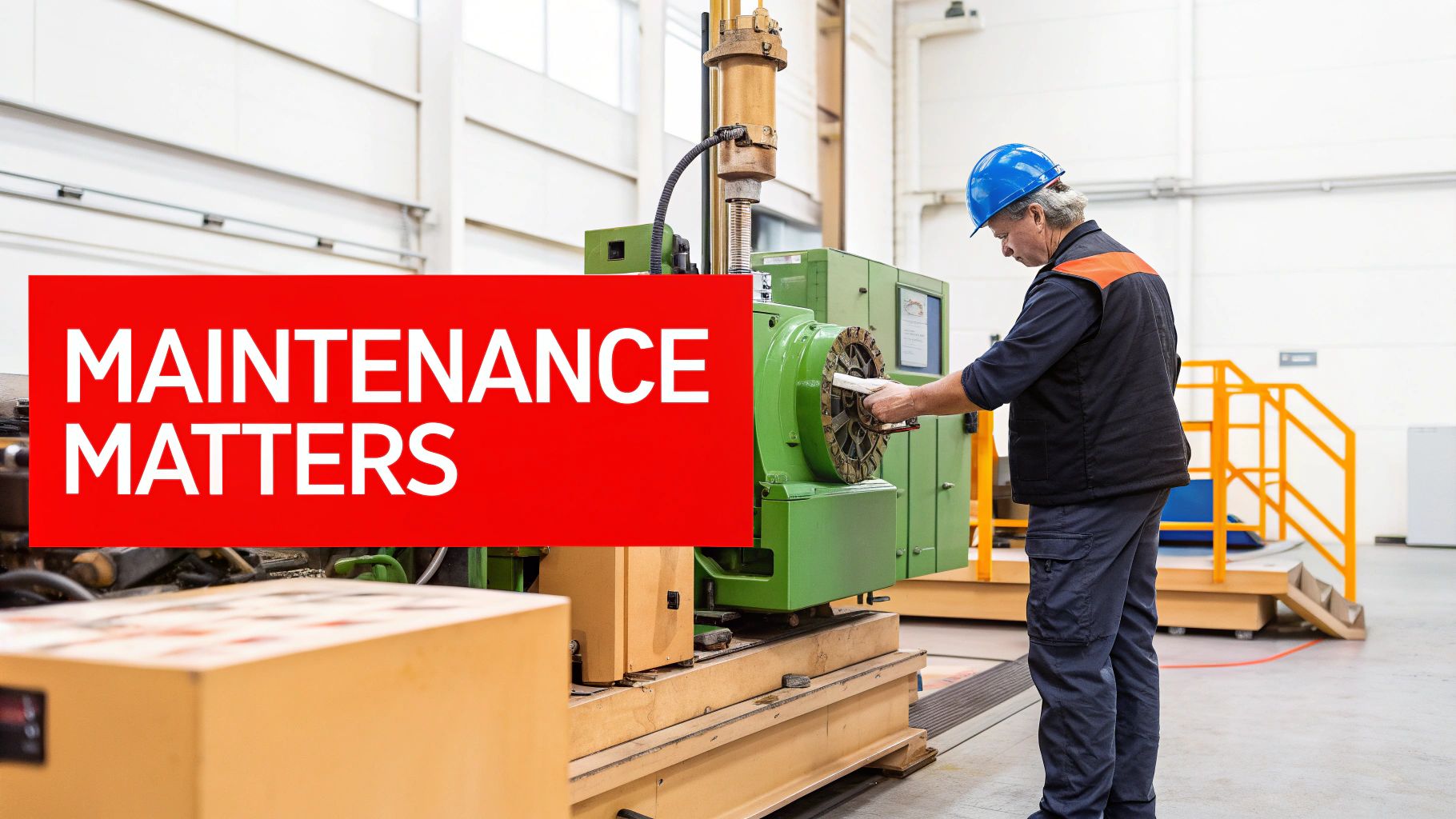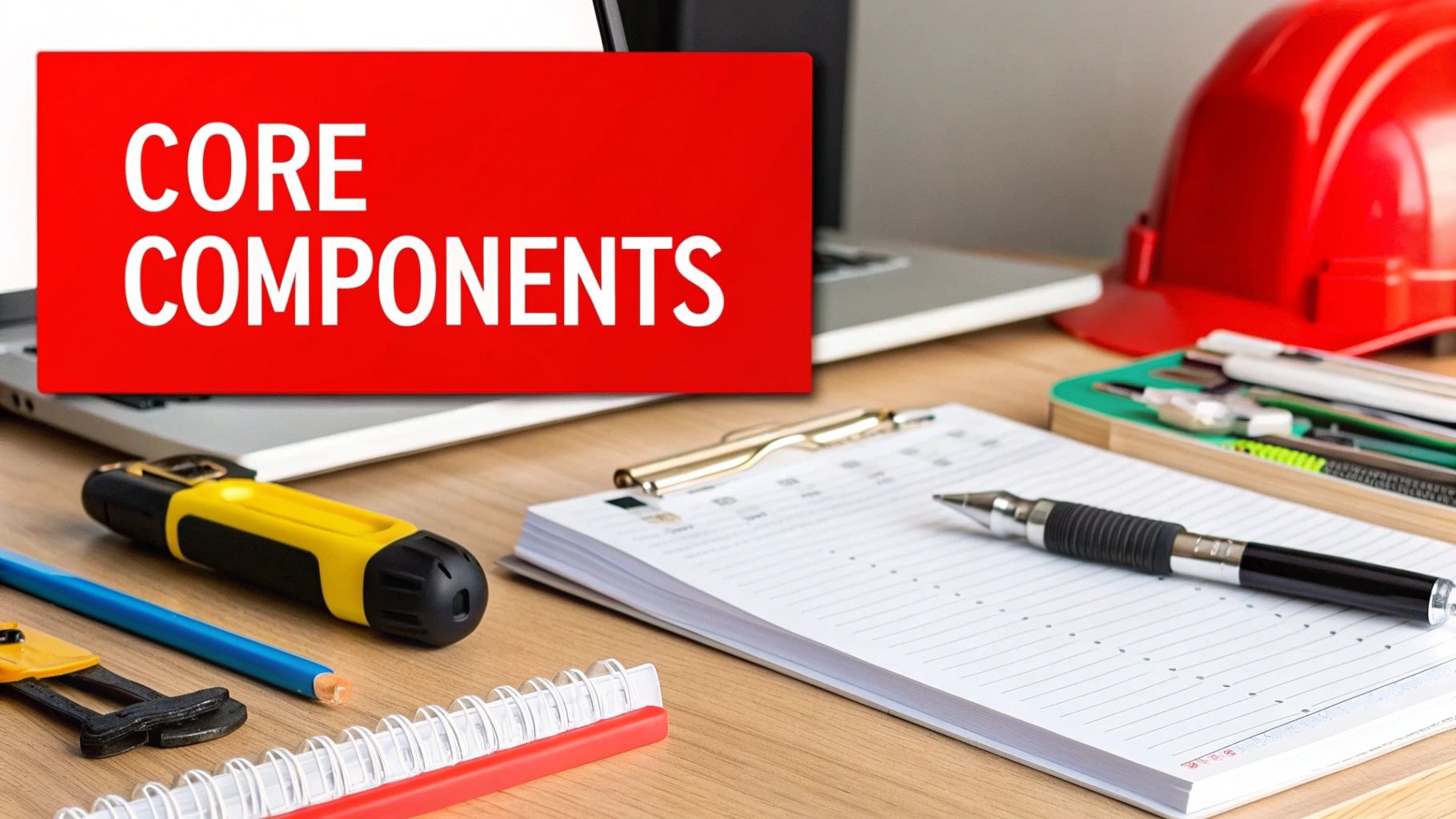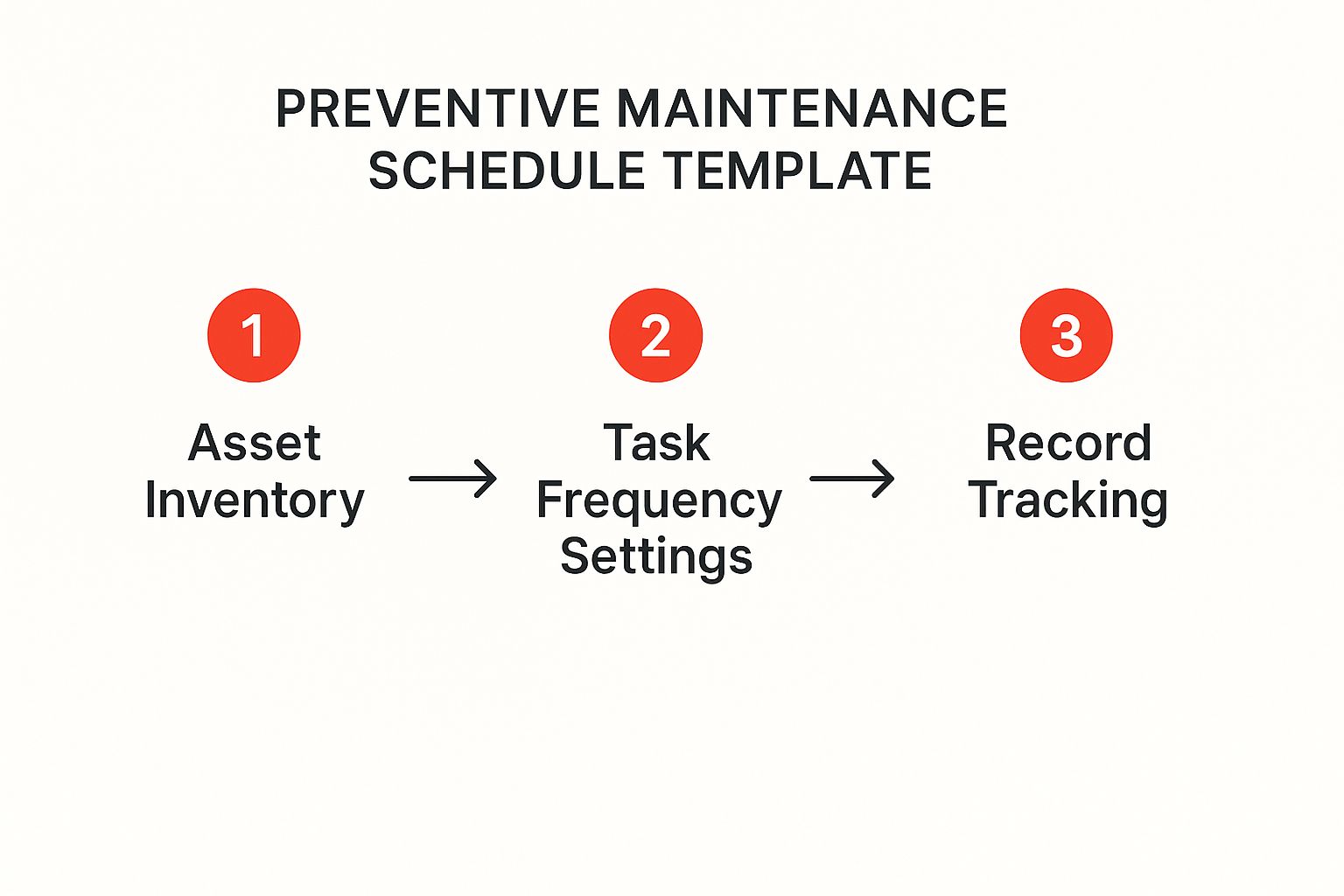A preventive maintenance schedule template is your playbook for asset care—a strategic document detailing what to check, how often, and who's responsible. Instead of reacting to a breakdown and scrambling for a fix, you get ahead of problems. According to studies, a well-implemented preventive maintenance program can result in a return on investment (ROI) as high as 545%. This proactive approach is a game-changer for businesses in Texas and Oklahoma, saving significant time and money by catching small issues before they snowball into catastrophic system failures.
Why Proactive Maintenance Is a Financial Necessity

An unexpected equipment failure is never just an inconvenience—it's a direct hit to your bottom line. For any business in Texas or Oklahoma, a single breakdown can trigger a cascade of serious financial losses.
Picture this: a warehouse in Dallas has a loading dock door jam shut. Suddenly, shipments stop, deadlines are missed, and client relationships are strained. Or consider a facility in Houston where constant humidity causes untreated metal parts to corrode, leading to a sudden, catastrophic collapse. These aren't just "what-if" scenarios; they're the expensive reality of a reactive "fix it when it breaks" mindset. A preventive maintenance schedule is your strategic defense against these emergencies.
The True Cost of Downtime
When you're stuck in reactive mode, the final repair bill is only the beginning of your financial headache. The hidden costs are what truly hurt.
- Lost Productivity: Every minute your equipment is down, your operation grinds to a halt. Studies show that unplanned downtime can cost industrial manufacturers up to $50 billion annually.
- Overtime Labor: Emergency repairs rarely happen during standard business hours. You're often paying premium rates for after-hours or weekend work, which can be 50-100% higher than standard labor costs.
- Damaged Reputation: When you can't deliver on time, customer confidence erodes. In a competitive market, this can be the most damaging cost of all.
- Safety Risks: A poorly maintained system is a direct violation of OSHA's General Duty Clause (Section 5(a)(1)), which requires employers to provide a workplace free from recognized hazards. Negligence can lead to injuries, hefty fines, and increased insurance premiums.
Here's where planning makes a quantifiable difference. According to industry data, planned maintenance requires, on average, half the time and a fraction of the cost of a reactive, emergency repair. By simply following a schedule, you can slash maintenance labor hours and redirect those resources toward growth.
A solid maintenance plan does more than prevent breakdowns. It protects your capital assets, ensures operational continuity, and shields your revenue from the chaos of an unplanned shutdown. It’s a direct investment in stability and profitability.
Protecting Your Commercial Assets
For businesses relying on commercial overhead doors, the stakes are even higher. A malfunctioning door can compromise building security, snarl your supply chain, and create a significant safety risk for employees and visitors.
Regular, proactive inspections are designed to spot issues like frayed cables or worn-out springs before they fail. When a problem does arise, you need a reliable partner. Our team is always ready to handle emergency commercial overhead door repair to restore your operations quickly and safely. By committing to regular upkeep, you shift from constantly putting out fires to strategically protecting your most critical assets.
Conducting Your Essential Equipment Audit

Before building a maintenance schedule, you must know exactly what you’re working with. This is where an equipment audit comes in. It's the foundational step where you gather critical details about every asset, from your commercial garage doors to the automated security gates out front.
This isn't just about making a list; it’s about understanding the specific operational demands and maintenance needs of each piece of equipment. This initial legwork is what transforms a generic checklist into an effective plan that actively prevents breakdowns.
Gathering Your Asset Intelligence
Your first move is to create a master list of all relevant equipment. For each asset, document these key details:
- Asset Name and Location: Be specific. Instead of "Loading Dock Door," use "North Bay Loading Dock Door 3." Clear identification prevents errors.
- Manufacturer and Model Number: This is non-negotiable for ordering correct parts and accessing service manuals.
- Serial Number and Installation Date: An asset's age helps you anticipate when major components might reach their end-of-life.
- Operational Demands: This is critical. A high-cycle door opening 100+ times a day has vastly different maintenance needs than one used only 10 times. Note the cycle count.
- Maintenance History: Document past repairs and part replacements. This data provides clues to recurring issues.
This systematic approach is precisely why preventive maintenance is the most widely used maintenance strategy. A solid template provides the framework to reduce costly failures by methodically addressing wear and tear.
From Audit Data to Actionable Insights
With your inventory complete, dive into the manufacturer's documentation for each piece of equipment. The owner’s manual is your primary source for recommended service intervals and specific tasks. It will detail everything from lubrication points to spring tension checks.
Don't stop there. Cross-reference that information with industry best practices and standards. Organizations like DASMA (Door & Access Systems Manufacturers Association) and standards like NFPA 80 (for fire doors) provide critical benchmarks that ensure your plan is comprehensive and compliant.
An equipment audit transforms guesswork into a clear plan of action. It provides the hard data you need to make smart decisions, ensuring every task on your schedule serves a real purpose.
This process is valuable whether you’re managing a single residential garage door or dozens of commercial access points. For homeowners, it might simply mean identifying their garage door opener model. For a business, it’s a critical component of asset management. If you need a refresher on the components involved, our guide on what is an overhead door is a great place to start.
Customizing Your Preventive Maintenance Template
You've audited your equipment. Now it's time to turn that raw data into a practical preventive maintenance schedule. A generic checklist won't suffice for the unique demands of a facility in Texas or Oklahoma. You're building a living document that will guide your team, track performance, and stop expensive failures before they happen.
The core of any good template includes: Asset ID, Task Description, Frequency, Assigned Personnel, Completion Date, and Notes. The 'Notes' column is your operational intelligence hub—it’s where you’ll document how West Texas dust is fouling lubricants faster than expected or track a specific garage door spring that’s showing early signs of fatigue.
This process, from inventorying your assets to creating a system for tracking records, is a logical flow.

As you can see, a solid asset inventory is the foundation. It directly informs the maintenance schedule you create, which in turn generates the data you'll track and analyze over time.
Building Your Template Framework
A well-designed template is simple, clear, and easy for anyone on your team to use. If you're looking for inspiration on structuring your own document, reviewing an essential property inspection checklist template can help you see how professionals organize information for clarity.
Let's break down the critical components for your template:
- Asset ID: Assign a unique identifier to every asset, like LD-01 for the loading dock door at Bay 1. This eliminates guesswork.
- Task Description: Be specific. "Check Door" is too vague. Instead, write, "Inspect roller tracks for debris; lubricate all moving parts with [specific lubricant type]." This ensures consistency and thoroughness.
- Frequency: Define how often each task occurs—weekly, monthly, quarterly. Start with manufacturer recommendations and adjust based on usage and local environmental factors (e.g., dust, humidity).
- Assigned Personnel: Clearly state who is responsible. This builds accountability and ensures qualified individuals handle critical jobs.
- Completion Date & Notes: This is your historical record. Documenting completion and observations creates a powerful data log for future troubleshooting and budget planning.
Your template isn’t just a schedule; it’s a communication tool. It ensures that everyone, from the facility manager in Abilene to the maintenance tech in Shawnee, is operating from the same playbook and upholding the same standards.
Sample Maintenance Tasks and Frequencies by Equipment Type
Here is a foundational checklist for common equipment in Texas and Oklahoma. This table outlines key tasks and a starting point for their frequency.
| Equipment Type | Task | Recommended Frequency (Residential) | Recommended Frequency (Commercial) |
|---|---|---|---|
| Sectional Garage Door | Inspect and lubricate springs, rollers, and hinges | Annually | Quarterly to Semi-Annually |
| Rolling Steel Door | Check guide alignment and curtain for damage | N/A | Quarterly |
| Garage Door Opener | Test safety reversal system and photo-eye sensors (per UL 325) | Monthly | Monthly to Quarterly |
| Loading Dock Leveler | Clean pit, inspect hydraulic/mechanical parts | N/A | Quarterly |
| Dock Seal/Shelter | Inspect for tears, wear, and proper sealing | N/A | Semi-Annually |
Remember, this is a baseline. A high-traffic distribution center in a dusty Texas environment may need to increase frequencies significantly compared to a small business in a cleaner Oklahoma suburb. Use this as your starting point and refine it based on real-world data.
Using Maintenance Data to Predict Future Failures
A good preventive maintenance schedule doesn't just prevent failures—it helps you see them coming. This is where you elevate your template from a simple checklist to a powerful forecasting tool. You're turning every routine check into an intelligence-gathering mission, moving from a reactive "fix-it" model to proactively managing asset health.
Your equipment is constantly providing data. Unusual noises, slight vibrations, or a door that's a bit slower—these are all early warning signs. The key is to document every observation in the "Notes" column. Over time, these data points create a clear picture, allowing you to connect the dots before a component fails.
From Data Collection to Predictive Insights
This is the heart of predictive maintenance on a practical, everyday level. Every time a technician is on-site, they should be looking for deviations from the baseline.
- Listen for Changes: Does a motor sound different? Is a roller gate making a new grinding noise?
- Observe Performance: Is a door taking a few extra seconds to open? Does a safety sensor seem less responsive?
- Track Minor Fixes: Documenting small adjustments is critical. If you're tightening the same bolt every quarter, you've identified a chronic vibration problem that needs a permanent solution, not a recurring patch.
This habit of logging data helps you forecast major component failures, plan for capital expenses, and schedule significant repairs during planned downtime instead of in the middle of a chaotic emergency.
The Financial Case for Predictive Maintenance
Shifting from a purely preventive to a more predictive model has a direct impact on your bottom line. The numbers are compelling: according to Deloitte, predictive maintenance can reduce maintenance costs by up to 40%, cut unplanned downtime by 50%, and extend the lifespan of aging assets by 20-40%. It's a direct answer to the 67% of facility managers who list aging equipment as a top concern, offering a smarter, data-backed approach to upkeep.
By meticulously tracking the small details, you gain the foresight to make strategic decisions. You’re no longer just maintaining equipment; you’re managing its entire lifecycle, maximizing its value and ensuring business continuity.
Ultimately, this intelligence turns your maintenance template from a static document into a dynamic strategic asset. It gives you the power to anticipate needs, allocate resources effectively, and dramatically reduce the risk of unexpected disruptions that can cripple any business in Texas or Oklahoma.
Putting Your Maintenance Plan Into Action

You’ve crafted a detailed preventive maintenance schedule. Now comes the most important part: execution. A plan on paper is worthless until it's implemented on the shop floor. Consistent execution is what transforms that document into a real asset that protects your equipment and keeps your operation running.
Actionable Tip: The easiest first step is to digitize your schedule. Use a shared calendar (like Google Calendar or Outlook) or a simple spreadsheet. For every task, create a recurring event and assign it to the responsible person with automated reminders. This simple action transforms maintenance from a "when I get to it" task into a non-negotiable appointment.
Assigning Clear Roles and Responsibilities
Accountability is the engine of any successful maintenance program. If no one knows who's responsible for what, critical tasks will be missed. That "Assigned Personnel" column in your template is non-negotiable.
Put a name next to every single task. Whether it's a quick visual check or a complex component inspection, someone must own it. This eliminates confusion and builds a culture of ownership over the equipment your team relies on daily.
A maintenance plan without assigned responsibility is just a wish list. True success comes when every team member knows their exact role in keeping your facility running smoothly and safely.
Knowing When to Call a Professional
Your in-house team can handle routine checks, but some jobs require certified professionals. Tasks involving high safety risks or specialized expertise, especially with automated doors governed by safety standards like UL 325, are best left to the pros.
Working with high-tension springs, servicing complex electrical systems, or calibrating safety sensors without proper training is a recipe for disaster and liability. These jobs should always be handled by certified technicians. Our rule of thumb is simple: if it requires specialized tools, involves electrical components, or deals with parts under extreme tension, it’s time to call a professional.
The Value of a Professional Maintenance Agreement
For businesses across Texas and Oklahoma, managing a comprehensive in-house maintenance program can be a major drain on time and resources. This is where a professional maintenance agreement becomes a smart, strategic investment. A formal agreement offloads the entire burden—from scheduling and performing work to maintaining detailed service records for compliance.
This partnership delivers tangible benefits:
- Guaranteed Compliance: Professionals are experts in industry codes (UL, NFPA, OSHA), ensuring your facility remains compliant and safe.
- Expert Technicians: You gain access to trained, insured technicians who can spot developing problems that in-house staff might miss.
- Priority Service: Clients with maintenance agreements typically receive priority scheduling for emergency repairs, significantly reducing potential downtime.
By partnering with a professional, you get consistent, expert care for your assets without diverting your own team from their core responsibilities. To see how a structured plan can protect your most important assets, explore our commercial garage door maintenance programs. It's a proactive step that keeps your facility safe, efficient, and always ready for business.
Answering Your Top Questions About Maintenance Templates
Putting a plan on paper is one thing, but making it work in the real world is another. Questions always pop up. Here are some of the most common ones we hear from facility and property managers across Texas and Oklahoma, along with some practical advice straight from our experience in the field.
How Much Does Our Crazy Weather Impact Maintenance?
The weather here is no joke, and it’s incredibly tough on your equipment. From the scorching summer heat in Texas to the sudden freezes in Oklahoma, the climate is always working against your doors. Metal expands and contracts, lubricants evaporate, and rubber seals dry out and crack faster than you’d expect.
Actionable Tip: We recommend a full professional inspection at least annually to address weather-related wear. In-house, you should perform visual checks and lubricate moving parts at least quarterly. For a high-cycle commercial door in a dusty environment, monthly checks are a must. Pay special attention to weather seals—they are your primary defense against dust, pests, and energy loss.
What's the Biggest Mistake You See People Make?
Hands down, the single biggest mistake is treating the maintenance schedule like a "set it and forget it" document. A good maintenance plan is a living thing; it's not a static checklist you laminate and hang on the wall. It needs to be updated after every single service call, repair, or equipment change.
The real value comes from the data you collect. If you aren't logging notes about a strange noise you heard, or adjusting how often you check a specific part based on its wear pattern, you're missing the point. Just ticking boxes without thinking critically is a fast track to an unexpected—and expensive—breakdown.
Is a Digital Template Really Better Than Paper?
A paper checklist is a decent start—it's certainly better than nothing. But for any modern operation, going digital is a game-changer. Whether you use a simple spreadsheet or a dedicated maintenance app, a digital template gives you advantages that paper just can't compete with.
- It’s always up-to-date. Changes are reflected instantly for the entire team.
- You get automated reminders. Calendar alerts ensure critical tasks are never missed.
- All your history is in one place. The complete service history is just a click away, which is invaluable for troubleshooting and proving compliance.
- You can spot trends. Over time, your digital log becomes a powerful tool that helps you see patterns and predict when a failure is likely to happen.
Ultimately, a digital template turns a simple chore list into a strategic asset for managing your facility’s most important equipment.
At Overhead Door Co. of Tex-Oma, we specialize in creating comprehensive maintenance plans that protect your investment and keep your business moving. Contact our team today to schedule a consultation and learn how we can support your facility.
